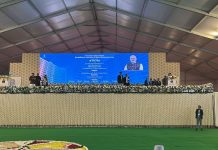*Emphasises on infrastructural growth

New Delhi- Prime Minister Narendra Modi on Sunday inaugurated and laid the foundation stone for a series of ambitious airport projects across India, with a combined value exceeding Rs 9, 800 crore.
In a landmark event, the Prime Minister marked the inauguration of 12 new Terminal Buildings in key locations including Pune, Kolhapur, Gwalior, Jabalpur, Delhi, Lucknow, Aligarh, Azamgarh, Chitrakoot, Moradabad, Shravasti, and Adampur Airports.
Additionally, he laid the foundation stone for three new Terminal Buildings at Kadapa, Hubballi, and Belagavi Airports.
Highlighting the remarkable pace of development, PM Modi underscored that the Gwalior terminal was completed in just 16 months, showcasing the government’s commitment to efficient project execution.
“This initiative will make air travel easier and accessible for the common citizens of the country, ” he asserted, countering allegations of electioneering tactics.
Addressing concerns about project completion, the Prime Minister said: “The record of the government in completing announced projects on time repudiates the allegation of these projects being election gimmicks.”
He reiterated his dedication to creating a developed India, saying: “People are seeing that Modi is made of different material. I am working relentlessly to create a Viksit Bharat.”
PM Modi underscored the holistic approach to infrastructure development, noting that alongside airport projects, investments were also being made in highways, railways, education, water, and the environment.
The inauguration of these projects is expected to significantly boost the civil aviation sector. The 12 new Terminal Buildings will collectively have the capacity to serve 620 lakh passengers annually, while the three terminals under construction will add capacity for an additional 95 lakh passengers per annum upon completion.
These modern Terminal Buildings boast state-of-the-art passenger amenities and incorporate sustainability features such as double-insulated roofing systems, energy-saving canopies, and LED lighting.
Moreover, the designs draw inspiration from local heritage structures, reflecting the unique culture and heritage of each region.












